
C12
.pdf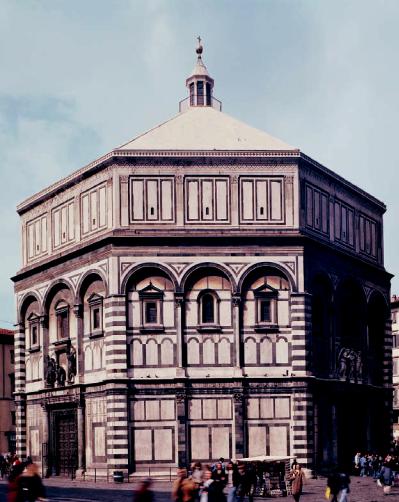
Muslims off Palermo in Sicily in 1062 provided the funds for the Pisan building program. The cathedral, its freestanding bell tower, and the baptistery, where infants and converts were initiated into the Christian community, present a rare opportunity to study a coherent group of three Romanesque buildings. Save for the upper portion of the baptistery, with its remodeled Gothic exterior, the three structures are stylistically homogeneous.
Construction of Pisa Cathedral began first—in 1063, the same year work began on Saint Mark’s (FIG. 9-24) in Venice, another powerful maritime city. Pisa Cathedral is large, with a nave and four aisles, and is one of the most impressive and majestic of all Romanesque churches. According to a document of the time, the Pisans wanted their bishop’s church not only to be a monument to the glory of God but also to bring credit to the city. At first glance, the cathedral resembles an Early Christian basilica with a timber roof, columnar arcade, and clerestory. But the broadly projecting transept with apses, the crossing dome, and the facade’s multiple arcaded galleries distinguish it as Romanesque. So too does the rich marble incrustation (wall decoration consisting of bright panels of different colors, as in the Pantheon’s interior, FIG. 7-51). The cathedral’s campanile, detached in the standard Italian fashion, is Pisa’s famous Leaning Tower (FIG. 12-25, right). Graceful arcaded galleries mark the tower’s stages and repeat the cathedral’s facade motif, effectively relating the round campanile to its mother building. The tilted vertical axis of the tower is the result of a settling foundation. The tower began to “lean” even while under construction and by the late 20th century had inclined some 5.5 degrees (about 15 feet) out of plumb at the top. In 1999 an international team of scientists
12-26 Baptistery of San Giovanni, Florence, Italy, dedicated 1059.
The Florentine baptistery is a domed octagon descended from Roman and Early Christian central-plan buildings. The distinctive Tuscan Romanesque marble paneling stems from Roman wall designs.
began a daring project to remove soil from beneath the north side of the tower. The soil extraction has already moved the tower more than an inch closer to vertical and ensured the stability of the structure for at least 300 years. (Because of the touristic appeal of the Leaning Tower, there are no plans to restore the campanile to its original upright position.)
BAPTISTERY, FLORENCE The public always associates Florence with the Renaissance of the 15th and 16th centuries, but Florence was already an important independent city-state in the Romanesque period. The gem of Florentine Romanesque architecture is the baptistery (FIG.
12-26) of San Giovanni (Saint John), the city’s patron saint. Pope Nicholas II dedicated the building in 1059. It thus predates Pisa’s baptistery (FIG. 12-25, left), but construction of the Florentine baptistery continued into the next century. Both baptisteries face their city’s cathedral. These freestanding Italian baptisteries are unusual and reflect the great significance the Florentines and Pisans attached to baptisms. On the day of a newborn child’s anointment, the citizenry gathered in the baptistery to welcome a new member into the community. The Tuscan baptisteries therefore were important civic as well as religious structures. Some of the most renowned artists of the late Middle Ages and the Renaissance provided the Florentine and Pisan baptisteries with pulpits (FIG. 14-2), bronze doors (FIGS. 16-2, 16-3, and 16-10), and mosaics.
The simple and serene classicism of San Giovanni’s design recalls ancient Roman architecture. The baptistery stands in a direct line of descent from the Pantheon (FIG. 7-49) and imperial mausoleums such as Diocletian’s (FIG. 7-74), the Early Christian Santa Costanza (FIG. 8-11), the Byzantine San Vitale (FIG. 9-6), and other central-plan structures, pagan or Christian, including Charlemagne’s Palatine Chapel (FIG. 11-18) at Aachen. The distinctive Tuscan Romanesque marble incrustation that patterns the walls stems ultimately from Roman wall designs (FIGS. 7-17 and 7-51). The simple oblong and arcuated panels assert the building’s structural lines and its elevation levels. In plan, San Giovanni is a domed octagon, wrapped on the exterior by an elegant arcade, three arches to a bay. It has three entrances, one each on the north, south, and east sides. On the west side an oblong sanctuary replaces the original semicircular apse. The domical vault is some 90 feet in diameter, its construction a remarkable feat for its time.
Italy 329

12-27 Interior of San Miniato al Monte, Florence, Italy, ca. 1062–1090.
The design of San Miniato is close to that of Early Christian basilicas, but diaphragm arches divide the nave into three equal compartments, and compound piers alternate with columns in the arcade.
SAN MINIATO AL MONTE Contemporaneous with the San Giovanni baptistery and also featuring elaborate marble incrustation is the Benedictine abbey church of San Miniato al Monte (FIG. 12-27). It sits, as its name implies, on a hillside overlooking the Arno River and the heart of Florence. The builders completed the body of the church by 1090, its facade not until the early 13th century. Even more than Pisa Cathedral, the structure recalls the Early Christian basilica, but diaphragm arches divide its nave into
12-28 WILIGELMO,
creation and temptation of Adam and Eve,
detail of the frieze on the west facade, Modena Cathedral, Modena, Italy, ca. 1110. Marble, 3 high.
For Modena’s cathedral, Wiligelmo represented scenes from Genesis against an architectural backdrop of a type common on Roman and Early Christian sarcophagi, which were plentiful in the area.
three equal compartments. The arches rise from compound piers and brace the rather high, thin walls. They also provide firebreaks beneath the wooden roof and compartmentalize the basilican interior in the manner so popular with most Romanesque builders. The compound piers alternate with pairs of simple columns with Roman-revival Composite capitals.
MODENA CATHEDRAL Despite the pronounced structural differences between Italian Romanesque churches and those of France, Spain, and the Holy Roman Empire, Italian church officials also frequently employed sculptors to adorn the facades of their buildings. In fact, one of the first examples of fully developed narrative relief sculpture in Romanesque art is the marble frieze (FIG. 12-28) on the facade of Modena Cathedral in northern Italy. Carved around 1110, it represents scenes from Genesis set against an architectural backdrop of a type common on Roman and Early Christian sarcophagi, which were plentiful in the area. The segment in FIG. 12-28 illustrates the creation and temptation of Adam and Eve (Gen. 2, 3:1–8), the theme employed almost exactly a century earlier on Bishop Bernward’s bronze doors (FIG. 11-24) at Hildesheim. At Modena, as at Saint Michael’s, the faithful entered the Lord’s house with a reminder of Original Sin and the suggestion that the only path to salvation is through the Christian Church.
On the Modena frieze, Christ is at the far left, framed by a mandorla held up by angels—a variation on the motif of the Saint-Sernin ambulatory relief (FIG. 12-7). The creation of Adam, then Eve, and the serpent’s temptation of Eve are to the right. The relief carving is high, and some parts are almost entirely in the round. The frieze is the work of a master craftsman whose name, WILIGELMO, is given in an inscription on another relief on the facade. There he boasts, “Among sculptors, your work shines forth, Wiligelmo.” The inscription is also an indication of the pride Wiligelmo’s patrons had in obtaining the services of such an accomplished sculptor for their city’s cathedral.
BENEDETTO ANTELAMI The reawakening of interest in stone sculpture in the round also may be seen in northern Italy, where the sculptor BENEDETTO ANTELAMI was active in the last quarter of the 12th century. Several reliefs by his hand exist, including Parma Cathedral’s pulpit and the portals of that city’s baptistery. But his most unusual works are the monumental marble statues of two Old Testament figures he carved for the west facade of Fidenza Cathedral. Benedetto’s King David (FIG. 12-29) seems confined within his niche, and he holds his elbows close to his body. Absent is
1 ft.
330 Chapter 12 RO M A N E S QU E E U RO P E

1 ft.
12-29 BENEDETTO ANTELAMI, King David, statue in a niche on the west facade of Fidenza Cathedral, Fidenza, Italy, ca. 1180–1190. Marble, life-size.
Benedetto Antelami’s King David on the facade of Fidenza Cathedral is a rare example of life-size statuary in the Romanesque period. The style is unmistakably rooted in Greco-Roman art.
the weight shift that is the hallmark of classical statuary. Yet the sculptor’s conception of this prophet is unmistakably rooted in Greco-Roman art. Comparison of the Fidenza David with the prophet on the Moissac trumeau (FIG. 12-11), who also displays an unfurled scroll, reveals how much the Italian sculptor freed his figure from its architectural setting. Other sculptors did not immediately emulate Antelami’s classical approach to portraying biblical figures in stone. But the idea of placing freestanding statues in niches would be taken up again in Italy by Early Renaissance sculptors (FIGS. 16-4 to 16-6).
12-30 West facade of Saint-Étienne, Caen, France, begun 1067.
The division of Saint-Étienne’s facade into three parts corresponding to the nave and aisles reflects the methodical planning of the entire structure. The towers also have a tripartite design.
NORMANDY AND ENGLAND
After their conversion to Christianity in the early 10th century, the Vikings (see Chapter 11) settled on the northern coast of France in present-day Normandy. Almost at once, they proved themselves not only aggressive warriors but also skilled administrators and builders, active in Sicily (FIG. 9-25) as well as in northern Europe.
Architecture
The Normans quickly developed a distinctive Romanesque architectural style that became the major source of French Gothic architecture.
SAINT-ÉTIENNE, CAEN Most critics consider the abbey church of Saint-Étienne at Caen the masterpiece of Norman Romanesque architecture. Begun by William of Normandy (William the Conqueror; see page 333) in 1067, work must have advanced rapidly, because he was buried there in 1087. Saint-Étienne’s west facade (FIG. 12-30) is a striking design rooted in the tradition of Carolingian and Ottonian westworks, but it reveals a new unified
Nor mandy and England |
331 |
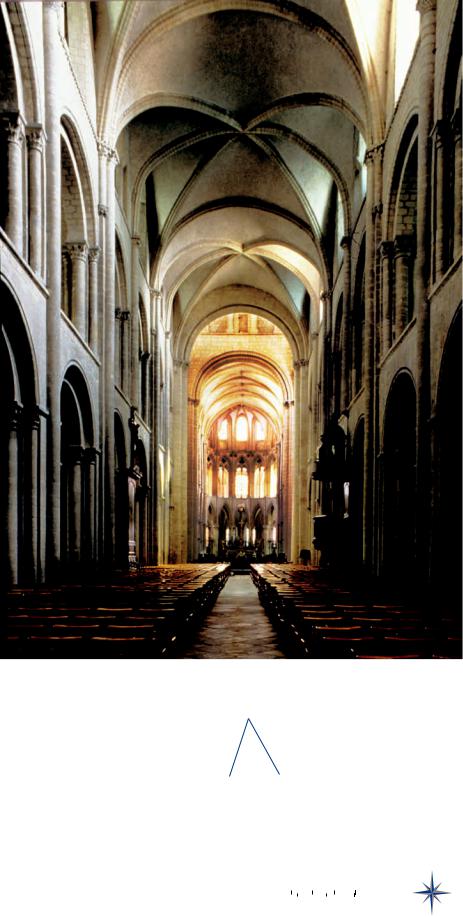
12-31 Interior of Saint-Étienne, Caen, France, vaulted ca. 1115–1120.
The groin vaults of Saint-Étienne made possible an efficient clerestory. The three-story elevation with its large arched openings provides ample light and makes the nave appear taller than it is.
design. Four large buttresses divide the facade into three bays that correspond to the nave and aisles. Above the buttresses, the towers also display a triple division and a progressively greater piercing of their walls from lower to upper stages. (The culminating spires are a Gothic addition.) The tripartite division extends throughout the facade, both vertically and horizontally, organizing it into a closeknit, well-integrated design that reflects the careful and methodical planning of the entire structure.
The original design of Saint-Étienne called for a wooden roof, as originally at Speyer Cathedral. But the Caen nave (FIG. 12-31) had compound piers with simple engaged half-columns alternating with piers with half-columns attached to pilasters. When the builders decided to install groin vaults around 1115, the existing alternating compound piers in the nave proved a good match. Those piers soar all the way to the vaults’ springing. Their branching ribs divide the large square-vault compartments into six sections, making a sexpartite vault (FIG. 12-32). The vaults rise high enough to provide room for an efficient clerestory. The resulting three-story elevation, with its large arched openings, admits more light to the interior. It also makes the nave appear even taller than it is. As in the Milanese church of
Sant’Ambrogio (FIG. 12-21), the Norman building has rib vaults. The diagonal and transverse ribs compose a structural skeleton that partially supports the still fairly massive paneling between them. Despite the heavy masonry, the large windows and reduced interior wall surface give Saint-Étienne’s nave a light and airy quality that is unusual in the Romanesque period.
DURHAM CATHEDRAL William of Normandy’s conquest of Anglo-Saxon England in 1066 began a new epoch in English history. In architecture, it signaled the importation of Norman Romanesque building and design methods. Durham Cathedral (FIGS. 12-33 and 12-34) sits majestically on a cliff overlooking the Wear River in northern England, the centerpiece of a monastery, cathedral, and fortified-castle complex on the Scottish frontier. Unlike Speyer Cathedral and Saint-Étienne, Durham Cathedral, begun around 1093—earlier than the remodeled Caen church—was a vaulted structure from the very beginning. Consequently, the pattern of the ribs of the nave’s groin vaults corresponds perfectly to the design of the arcade below. Each seven-part nave vault covers two bays. Large,
332 Chapter 12 RO M A N E S QU E E U RO P E
Sexpartite
vaults
N
11th to early 12th century |
0 |
25 |
|
50 |
|
|
75 100 feet |
||||
13th century |
|
|
|
||||||||
|
|
|
|
|
|
|
|
|
|
|
|
|
|
|
|
|
|
|
|
|
|||
14th century |
0 |
10 |
|
|
20 |
|
30 meters |
||||
|
|
|
|
|
|
|
|
|
|
|
|
12-32 Plan of Saint-Étienne, Caen, France.
The early-12th-century nave vaults of Saint-Étienne spring from compound piers with alternating half-columns and pilasters. The diagonal and transverse ribs divide the vaults into six compartments.
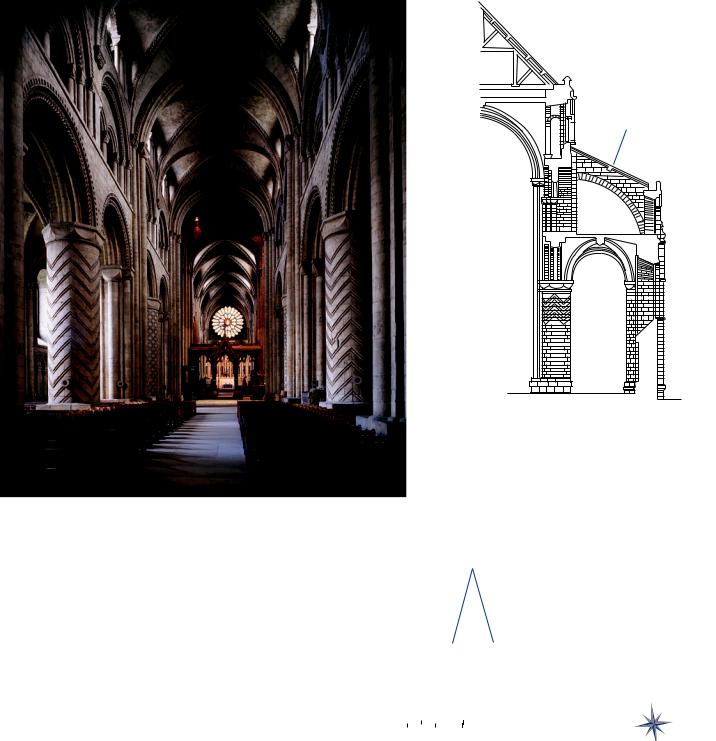
simple pillars ornamented with abstract designs (diamond, chevron, and cable patterns, all originally painted) alternate with compound piers that carry the transverse arches of the vaults. The pier-vault relationship scarcely could be more visible or the building’s structural rationale better expressed.
The bold surface patterning of the Durham nave is a reminder that the raising of imposing stone edifices such as the Romanesque churches of England and Normandy required more than just the talents of master designers. A corps of expert masons had to transform rough stone blocks into the precise shapes necessary for their specific place in the church’s fabric. Although thousands of simple quadrangular blocks make up the great walls of these buildings, the builders needed large numbers of blocks in much more complex shapes. To cover the nave and aisles, the stonecutters had to carve blocks with concave faces to conform to the curve of the vault. Also required were blocks with projecting moldings for the ribs, blocks with convex surfaces for the pillars or with multiple profiles for the compound piers, and so forth. It was an immense undertaking, and it is no wonder that medieval building campaigns often lasted for decades.
The plan (FIG. 12-34) of Durham Cathedral is typically English with its long, slender proportions. It does not employ the modular scheme with the same care and logic seen at Caen. But in other ways this English church is even more innovative than the French church. It is the earliest example known of a ribbed groin vault placed over a three-story nave. And in the nave’s western parts, completed before 1130, the rib vaults have slightly pointed arches, bringing together for the first time two of the key elements that determined the struc-
Quadrant arch
12-33 Interior (left) and lateral section (right) of Durham Cathedral, England, begun ca. 1093.
Durham Cathedral is the first example of a ribbed groin vault placed over a three-story nave. Quadrant arches were used in place of groin vaults in the tribune to buttress the nave vaults.
Seven-part vaults
Addition
N
0 |
50 |
|
|
100 feet |
|||
|
|
|
|
|
|
|
|
|
|
|
|
|
|
||
0 |
10 |
|
20 |
30 meters |
|||
12-34 Plan of Durham Cathedral, England (after Kenneth John
Conant).
Durham Cathedral is typically English in its long, slender proportions. In the nave, simple pillars alternate with compound piers that support the transverse arches of the seven-part groin vaults.
tural evolution of Gothic architecture. Also of great significance is the way the English builders buttressed the nave vaults. The lateral section (FIG. 12-33, right) reveals that simple quadrant arches (arches whose curve extends for one quarter of a circle’s circumference) take the place of groin vaults in the tribune. The structural descendants of these quadrant arches are the flying buttresses that epitomize the mature Gothic solution to church construction (see “The Gothic Cathedral,” Chapter 13, page 347).
Nor mandy and England |
333 |
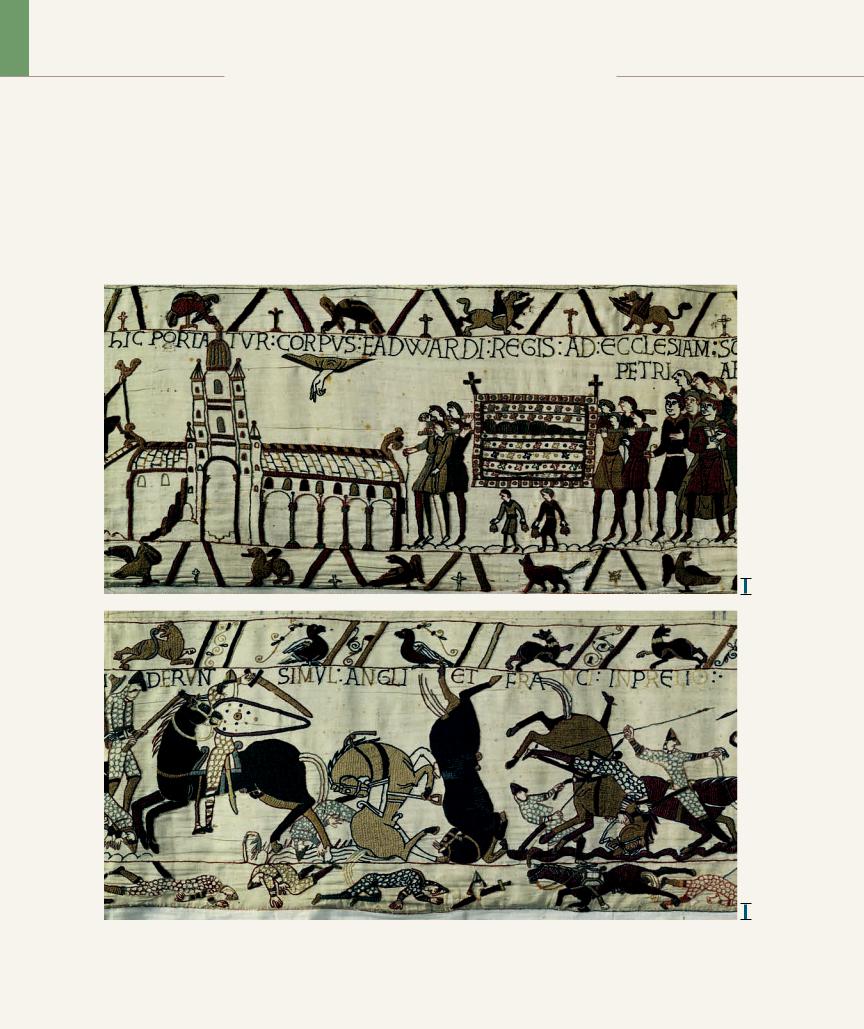
M A T E R I A L S A N D T E C H N I Q U E S
Embroidery and Tapestry
The most famous embroidery of the Middle Ages is, ironically, known as the Bayeux Tapestry (FIG. 12-35). Embroidery and tapestry are related but different means of decorating textiles. Tapestry designs are woven on a loom as part of the fabric. Embroidery pat-
terns are sewn onto fabric with threads.
The needleworkers who fashioned the Bayeux Tapestry were either Norman or English women. They employed eight colors of dyed wool—two varieties of blue, three shades of green, yellow, buff, and terracotta red—and two kinds of stitches. In stem stitching, short overlapping strands of thread form jagged lines. Laid-and-
couched work creates solid blocks of color. In the latter technique, the needleworker first lays down a series of parallel and then a series of cross stitches. Finally, the stitcher tacks down the cross-hatched threads using couching (knotting). On the Bayeux Tapestry, the embroiderers left the natural linen color exposed for the background, human flesh, building walls, and other “colorless” design elements. Stem stitches define the contours of figures and buildings and delineate interior details, such as facial features, body armor, and roof tiles. The clothing, animal bodies, and other solid areas are laid-and- couched work.
1 in.
1 in.
12-35 Funeral procession to Westminster Abbey (top) and Battle of Hastings (bottom), details of the Bayeux Tapestry, from Bayeux Cathedral, Bayeux, France, ca. 1070–1080. Embroidered wool on linen, 1 8 high (entire length of fabric 229 8 ).
Centre Guillaume le Conquérant, Bayeux.
The Bayeux Tapestry is unique in medieval art. Like historical narratives in ancient Roman art, it depicts contemporaneous events in full detail, as in the scroll-like frieze of Trajan’s Column (FIG. 7-44).
334 Chapter 12 RO M A N E S QU E E U RO P E

Painting and Other Arts
Many of the finest illustrated manuscripts of the Romanesque age were the work of monks in English scriptoria, following in the tradition of Hiberno-Saxon book production (see Chapter 16). But the most famous work of English Romanesque art is neither a book nor Christian in subject.
BAYEUX TAPESTRY The so-called Bayeux Tapestry (FIG. 12-35) is unique in medieval art. It is an embroidered fabric—not, in fact, a woven tapestry—made of wool sewn on linen (see “Embroidery and Tapestry,” page 334). Closely related to Romanesque manuscript illumination, its borders contain the kinds of real and imaginary animals found in contemporaneous books, and an explanatory Latin text sewn in thread accompanies many of the pictures. Some 20 inches high and about 230 feet long, the Bayeux Tapestry is a continuous, friezelike, pictorial narrative of a crucial moment in England’s history and of the events that led up to it. The Norman defeat of the AngloSaxons at Hastings in 1066 brought England under the control of the Normans, uniting all of England and much of France under one rule. The dukes of Normandy became the kings of England. Commissioned by Bishop Odo, the half brother of the conquering Duke William, the embroidery may have been sewn by women at the Norman court. Many art historians, however, believe it was the work of English stitchers in Kent, where Odo was earl after the Norman conquest. Odo donated the work to Bayeux Cathedral (hence its nickname), but it is uncertain whether it was originally intended for display in the church’s nave, where the theme would have been a curious choice.
The circumstances leading to the Norman invasion of England are well documented. In 1066, Edward the Confessor, the AngloSaxon king of England, died. The Normans believed Edward had recognized William of Normandy as his rightful heir. But the crown went to Harold, earl of Wessex, the king’s Anglo-Saxon brother-in- law, who had sworn allegiance to William. The betrayed Normans, descendants of the seafaring Vikings, boarded their ships, crossed the English Channel, and crushed Harold’s forces.
Illustrated here are two episodes of the epic tale as represented in the Bayeux Tapestry. The first detail (FIG. 12-35, top) depicts King Edward’s funeral procession. The hand of God points the way to the church in London where he was buried—Westminster Abbey, consecrated December 28, 1065, just a few days before Edward’s death. The church was one of the first Romanesque buildings erected in England, and the embroiderers took pains to record its main features, including the imposing crossing tower and the long nave with tribunes. Here William was crowned king of England on Christmas Day, 1066. (The coronation of every English monarch since then also has occurred in Westminster Abbey.) The second detail (FIG. 12-35, bottom) shows the Battle of Hastings in progress. The Norman cavalry cuts down the English defenders. The lower border is filled with the dead and wounded, although the upper register continues the animal motifs of the rest of the embroidery. The Romanesque artist co-opted some of the characteristic motifs of Greco-Roman battle scenes, for example, the horses with twisted necks and contorted bodies (compare FIG. 5-70). But the artists rendered the figures in the Romanesque manner. Linear patterning and flat color replaced classical three-dimensional volume and modeling in light and dark hues.
The Bayeux Tapestry stands apart from all other Romanesque artworks in that it depicts an event in full detail at a time shortly after it occurred, recalling the historical narratives of ancient Roman art. Art historians have often likened the Norman embroidery to the scrolllike frieze of the Column of Trajan (FIG. 7-44). Like the Roman account, the story told on the Bayeux Tapestry is the conqueror’s version
of history, a proclamation of national pride. And as in the ancient frieze, the narrative is not confined to battlefield successes. It is a complete chronicle of events. Included are the preparations for war, with scenes depicting the felling and splitting of trees for ship construction, the loading of equipment onto the vessels, the cooking and serving of meals, and so forth. In this respect, the Bayeux Tapestry is the most Roman-esque work of Romanesque art.
BURY BIBLE The Bury Bible (FIG. 12-36), produced at the Bury Saint Edmunds abbey in England around 1135, exemplifies the sumptuous illustration common to the large Bibles produced in wealthy Romanesque abbeys not subject to the Cistercian ban on luxurious illuminated manuscripts. These costly books lent prestige to monasteries that could afford them (see “Medieval Books,” Chapter 11, page 289). The artist responsible for the Bury Bible is known: MASTER HUGO, who was also a sculptor and metalworker. With Bernardus Gelduinus (FIG. 12-7), Gislebertus (FIG. 12-12), Rainer of Huy (FIG. 12-23), Wiligelmo (FIG. 12-28), and Benedetto Antelami (FIG. 12-29),
1 in.
12-36 MASTER HUGO, Moses expounding the Law, folio 94 recto of the Bury Bible, from Bury Saint Edmunds, England, ca. 1135. Ink and tempera on vellum, 1 8 1 2 . Corpus Christi College, Cambridge.
Master Hugo was a rare Romanesque lay artist, one of the emerging class of professional artists and artisans who depended for their livelihood on commissions from well-endowed monasteries.
Nor mandy and England |
335 |
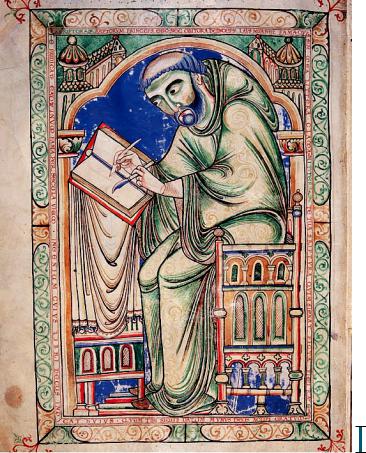
Hugo is one of the small but growing number of Romanesque artists who signed their works or whose names were recorded. In the 12th century, artists, illuminators as well as sculptors, increasingly began to identify themselves. Although most medieval artists remained anonymous, the contrast of the Romanesque period with the early Middle Ages is striking. Hugo seems to have been a secular artist, one of the emerging class of professional artists and artisans who depended for their livelihood on commissions from well-endowed monasteries. These artists resided in towns rather than within secluded abbey walls, and they traveled frequently to find work. They were the exception, however, and the typical Romanesque scribes and illuminators continued to be monks and nuns working anonymously in the service of God. The Benedictine Rule, for example, specified that “artisans in the monastery . . . are to practice their craft with all humility, but only with the abbot’s permission.”6
One page (FIG. 12-36) of the Bury Bible shows two scenes from Deuteronomy framed by symmetrical leaf motifs in softly glowing harmonized colors. The upper register depicts Moses and Aaron proclaiming the Law to the Israelites. Master Hugo represented Moses with horns, consistent with Saint Jerome’s translation of the Hebrew word that also means “rays” (compare Michelangelo’s similar conception of the Hebrew prophet, FIG. 17-15). The lower panel portrays Moses pointing out the clean and unclean beasts. The slow, gentle gestures convey quiet dignity. The figures of Moses and Aaron seem to glide. This presentation is quite different from the abrupt emphasis and spastic movement seen in earlier Romanesque paintings. The movements of the figures appear more integrated and smooth. Yet patterning remains in the multiple divisions of the draped limbs, the lightly shaded volumes connected with sinuous lines and ladderlike folds. Hugo still thought of the drapery and body as somehow the same. The frame has a quite definite limiting function, and the painter carefully fit the figures within it.
EADWINE PSALTER The Eadwine Psalter is the masterpiece of an English monk known as EADWINE THE SCRIBE. It contains 166 illustrations, many of which are variations of those in the Carolingian Utrecht Psalter (FIG. 11-15). The last page (FIG. 12-37), however, presents a rare picture of a Romanesque artist at work. The style of the Eadwine portrait resembles that of the Bury Bible, but although the patterning is still firm (notably in the cowl and the thigh), the drapery falls more softly and follows the movements of the body beneath it. Here, the abstract patterning of many Romanesque painted and sculpted garments yielded slightly, but clearly, to the requirements of more naturalistic representation. The Romanesque artist’s instinct for decorating the surface remained, as is apparent in the gown’s whorls and spirals. Significantly, however, the artist painted in those interior lines very lightly so that they would not conflict with the functional lines that contain them.
The “portrait” of Eadwine—it is probably a generic type and not a specific likeness—is in the long tradition of author portraits in ancient and medieval manuscripts (FIGS. 11-7, 11-13, 11-14, and 12-22), although the true author of the Eadwine Psalter is King David. Eadwine
1 in.
12-37 EADWINE THE SCRIBE, Eadwine the Scribe at work, folio 283 verso of the Eadwine Psalter, ca. 1160–1170. Ink and tempera on vellum. Trinity College, Cambridge.
Although he humbly offered his book as a gift to God, the English monk Eadwine added an inscription to his portrait declaring himself a “prince among scribes” whose fame would endure forever.
exaggerated his importance by likening his image to that of an evangelist writing his gospel and by including an inscription within the inner frame that identifies him and proclaims himself a “prince among scribes.” He declares that, due to the excellence of his work, his fame will endure forever and that he can offer his book as an acceptable gift to God. Eadwine, like other Romanesque sculptors and painters who signed their works, may have been concerned for his fame, but these artists, whether monks or laity, were not yet aware of the concepts of fine art and fine artist. To them, their work existed not for its own sake but for God’s. Nonetheless, works such as this one are an early sign of a new attitude toward the role of the artist in society that presages the emergence of the notion of individual artistic genius in the Renaissance.
336 Chapter 12 RO M A N E S QU E E U RO P E
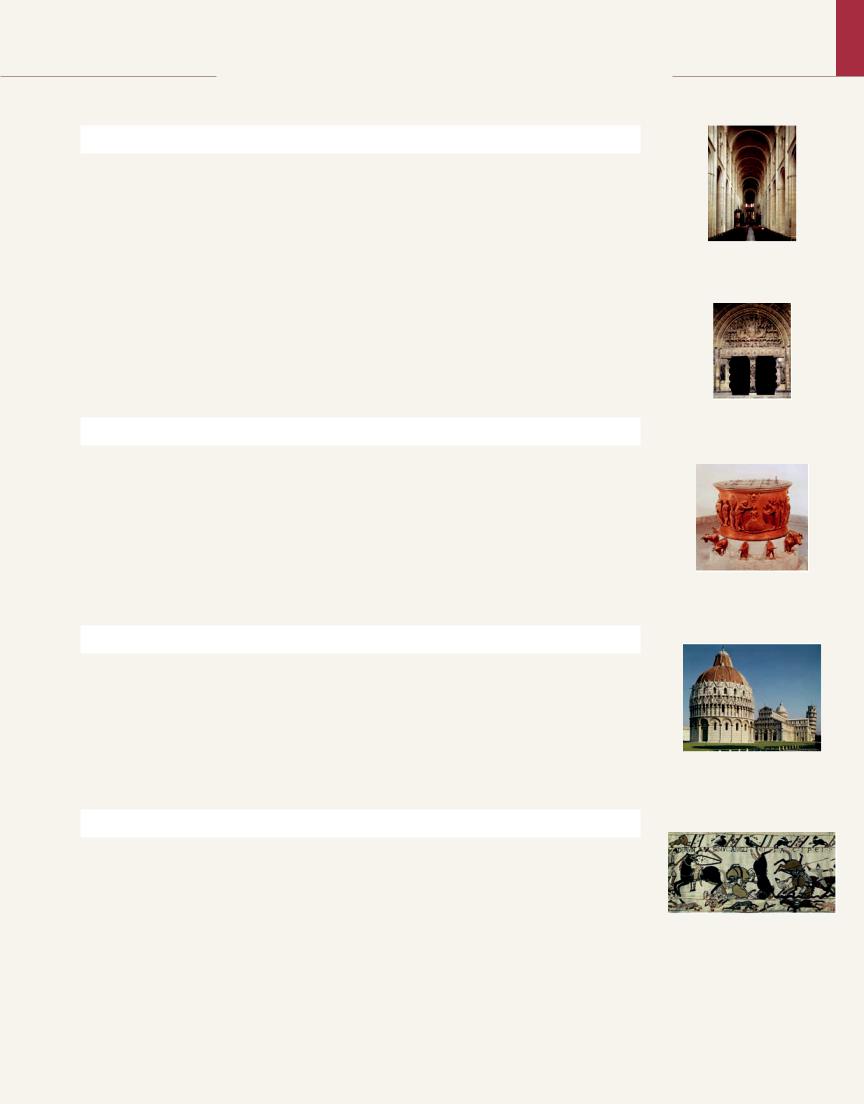
T H E B I G P I C T U R E
R O M A N E S Q U E E U R O P E
FRANCE AND NORTHERN SPAIN
Romanesque takes its name from the Roman-like barrel and groin vaults based on round arches employed in many European churches built between 1050 and 1200. Romanesque vaults, however, are made of stone, not concrete.
Numerous churches sprang up along the pilgrimage roads leading to the shrine of Saint James at Santiago de Compostela. These churches were large enough to accommodate crowds of pilgrims who came to view the relics displayed in radiating chapels off the ambulatory and transept.
The Romanesque period also brought the revival of monumental stone relief sculpture, especially on church facades, where scenes of Christ as Last Judge often greeted the faithful as they entered the doorway to salvation.
The leading patrons of Romanesque sculpture and painting were the monks of the Cluniac order. The Cistercians, under the leadership of Bernard of Clairvaux, condemned figural art in churches and religious books.
Saint-Sernin, Toulouse,
ca. 1070–1120
Saint-Pierre, Moissac, ca. 1115–1135
HOLY ROMAN EMPIRE
In the Romanesque period, the Salian dynasty (r. 1027–1125) ruled an empire that corresponds roughly to present-day Germany and northern Italy.
Architects in the Holy Roman Empire built structurally innovative churches. Speyer Cathedral and Sant’Ambrogio in Milan are two of the earliest examples of the use of groin vaults in naves.
In Belgium, sculptors excelled in metalwork, producing costly reliquaries of silver, jewels, and enamel. Rainer of Huy, one of several Romanesque artists whose name is known, cast a baptismal font in a single piece.
ITALY
The regional diversity of Romanesque art and architecture is especially evident in Italy, where the ancient Roman and Early Christian heritage was strongest.
Romanesque churches in Pisa and Florence have wooden roofs in contrast to the vaulted interiors of northern buildings. The exteriors often feature marble paneling of different colors. Church campaniles were usually freestanding, and baptisteries were independent central-plan buildings facing the cathedral.
NORMANDY AND ENGLAND
After their conversion to Christianity in the early 10th century, the Vikings settled on the northern coast of France. From there, Duke William of Normandy crossed the channel and conquered England in 1066. The Bayeux Tapestry chronicles that war—a unique example of contemporaneous historical narrative art in the Middle Ages.
Norman and English Romanesque architects introduced new features to church design that greatly influenced French Gothic architecture. Saint-Étienne at Caen and Durham Cathedral are the earliest examples of the use of rib groin vaults over a three-story nave elevation (arcade-tribune-clerestory). The Durham builders also experimented with quadrant arches in the tribune to buttress the nave vaults.
Rainer of Huy, baptismal font, 1118
Cathedral complex, Pisa, 11th–12th centuries
Bayeux Tapestry, ca. 1070–1080
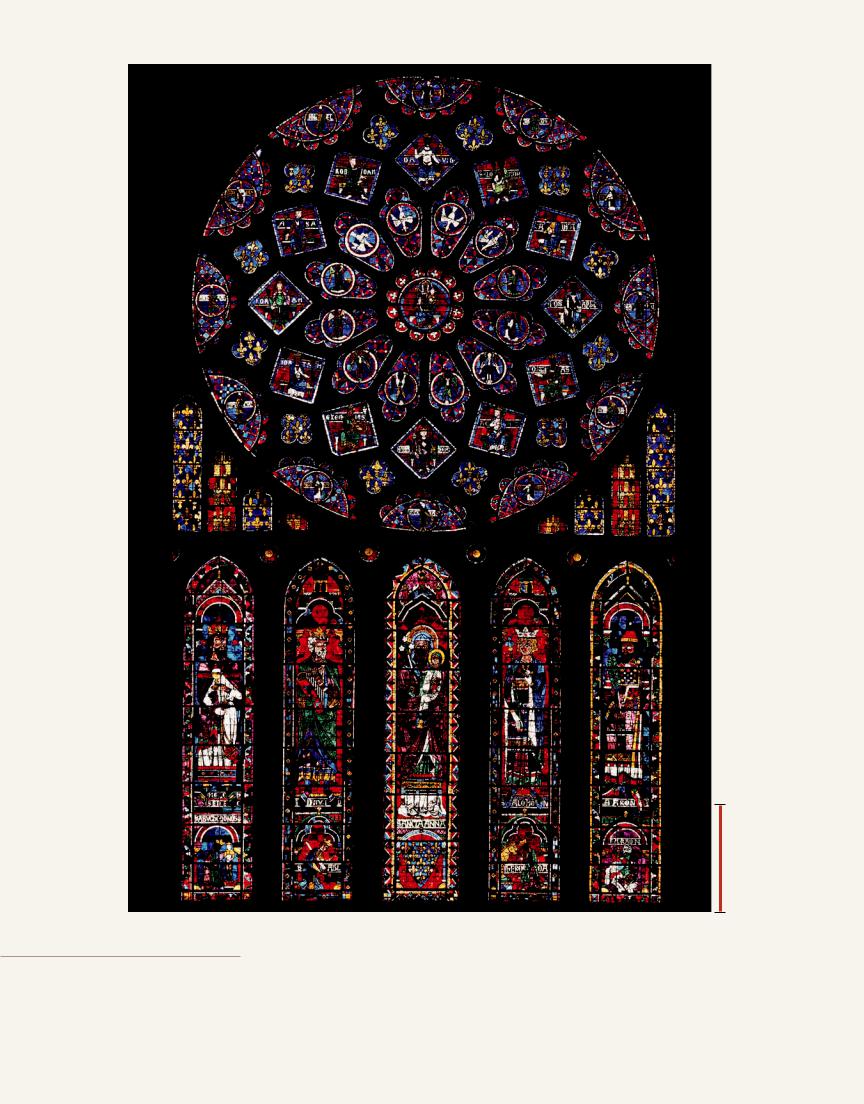
10 ft.
13-1 Rose window and lancets, north transept, Chartres Cathedral, Chartres, France, ca. 1220. Stained glass, rose window 43 in diameter.
The use of flying buttresses in Gothic cathedrals made possible the replacement of stone walls with immense stained-glass windows, which transformed natural sunlight into Abbot Suger’s divine lux nova.
